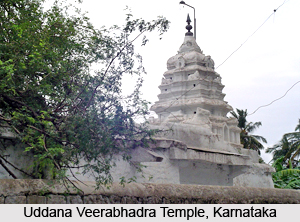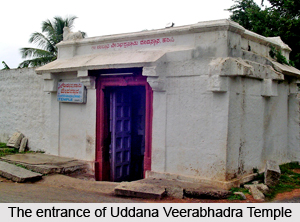 Uddana Veerabhadra Temple is amongst the most significant temples in the region of Hampi in Karnataka which is renowned for its remarkable architectural grandeur. It is present at the hill-top of Matanga which is known to be the highest point in Hampi area. Uddana Veerabhadra Temple`s presiding deity is Lord Veerabhadra who is revered as an incarnation of Lord Shiva. Here Lord Shiva is worshipped in the form of a Shiva Linga which is existent inside the temple. There is an idol of Uddana Veerabhadra which measures about 3.6 metres in height inside the temple sanctum and it is portrayed with four arms. Weapons like shield, arrow, bow and sword are held in the four arms of the deity. An idol of Daksha, the king of Gods stands inside the temple. `Sarvanga Linga`, a high Shiva linga is existent inside the temple.
Uddana Veerabhadra Temple is amongst the most significant temples in the region of Hampi in Karnataka which is renowned for its remarkable architectural grandeur. It is present at the hill-top of Matanga which is known to be the highest point in Hampi area. Uddana Veerabhadra Temple`s presiding deity is Lord Veerabhadra who is revered as an incarnation of Lord Shiva. Here Lord Shiva is worshipped in the form of a Shiva Linga which is existent inside the temple. There is an idol of Uddana Veerabhadra which measures about 3.6 metres in height inside the temple sanctum and it is portrayed with four arms. Weapons like shield, arrow, bow and sword are held in the four arms of the deity. An idol of Daksha, the king of Gods stands inside the temple. `Sarvanga Linga`, a high Shiva linga is existent inside the temple.
Legend of Uddana Veerabhadra Temple
 There are several legends which are associated with Uddana Veerabhadra Temple. According to a particular tale, Lord Shiva was disliked by Prajapati Daksha, though Sati who was his daughter wished to marry Lord Shiva. Finally, she was able to realise her dream of marrying Shiva. However, her father Daksha was infuriated by her action and invited all the Gods and Goddesses of heaven to a great `Mahayajna` organised at his palace, except Sati and her husband. When Sati sought the permission of Lord Shiva for visiting her father`s home as she was displeased with her father, she was forbidden to do so by Lord Shiva.
There are several legends which are associated with Uddana Veerabhadra Temple. According to a particular tale, Lord Shiva was disliked by Prajapati Daksha, though Sati who was his daughter wished to marry Lord Shiva. Finally, she was able to realise her dream of marrying Shiva. However, her father Daksha was infuriated by her action and invited all the Gods and Goddesses of heaven to a great `Mahayajna` organised at his palace, except Sati and her husband. When Sati sought the permission of Lord Shiva for visiting her father`s home as she was displeased with her father, she was forbidden to do so by Lord Shiva.
However, Sati refused to obey and visited Daksha`s palace. Daksha ignored his daughter who discovered that all the heavenly Gods were invited to the event including Lord Vishnu and Lord Brahma except her husband, Lord Shiva. Controlling her emotions, she went to the site of `Yajna`. Sati started criticizing the present people, when she realized Lord Shiva was the only God who was not invited there due to which Daksha hurled abuses against Lord Shiva. Enraged at the disregard for her husband, Sati sacrificed herself by jumping into the sacrificial fire of the Yajna. When Lord Shiva learnt the news, he was terribly upset and threw one of his tresses to the ground. From it, Mahakali and Veerbhadra emerged, who were ordered to damage the Mahayaga. Following Shiva`s instructions, they ruined the Yajna, chopped off the head of Daksha. Veerbhadra then threw the head into the Yajna Kund. All the Gods and Goddesses were scared of the violence and prayed and requested Lord Shiva to appear there. The wife of Daksha prayed to Him so that he would restore her husband`s life. Lord Shiva was moved by her tears and gave him back his life, but replaced his head with that of a goat.





















